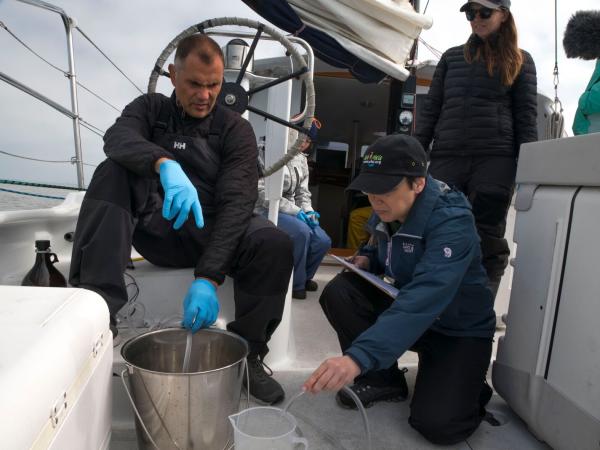Understanding Microplastic Levels, Pathways, and Transport in the San Francisco Bay Region
2019. Understanding Microplastic Levels, Pathways, and Transport in the San Francisco Bay Region. SFEI Contribution No. 950. San Francisco Estuary Institute: Richmond, CA.
 Microplastics (particles less than 5 mm) are ubiquitous and persistent pollutants in the ocean and a pervasive and preventable threat to the health of marine ecosystems. Microplastics come in a wide variety of shapes, sizes, and plastic types, each with unique physical and chemical properties and toxicological impacts. Understanding the magnitude of the microplastics problem and determining the highest priorities for mitigation require accurate measures of microplastic occurrence in the environment and identification of likely sources.
Microplastics (particles less than 5 mm) are ubiquitous and persistent pollutants in the ocean and a pervasive and preventable threat to the health of marine ecosystems. Microplastics come in a wide variety of shapes, sizes, and plastic types, each with unique physical and chemical properties and toxicological impacts. Understanding the magnitude of the microplastics problem and determining the highest priorities for mitigation require accurate measures of microplastic occurrence in the environment and identification of likely sources.
To develop critical baseline data and inform solutions, the San Francisco Estuary Institute and the 5 Gyres Institute have completed the first comprehensive regional study of microplastic pollution in a major estuary. This project supported multiple scientific components to develop improved knowledge about and characterization of microparticles and microplastics in San Francisco Bay and adjacent National Marine Sanctuaries, with the following objectives:
- Contribute to the development and standardization of sample collection and analysis methodology for microplastic transportation research.
- Determine a baseline for future monitoring of microplastics in San Francisco Bay surface water, sediment, and fish, and in ocean waters outside the Golden Gate.
- Characterize pathways by which microplastics enter the Bay, including urban stormwater and treated wastewater effluent.
- Investigate the contribution of Bay microplastics to the adjacent National Marine Sanctuaries through computer simulations.
- Communicate findings to regional stakeholders and the general public through meetings and educational materials.
- Facilitate evaluation of policy options for San Francisco Bay, with recommendations on source reduction.
This document presents the findings of this three-year project. A companion document, “San Francisco Bay Microplastics Project: Science-Supported Solutions and Policy Recommendations,” has been developed by 5 Gyres using the findings of this study (Box and Cummins, 2019).
Related Projects, News, and Events:
 Microplastic Pollution in San Francisco Bay (Project)
Microplastic Pollution in San Francisco Bay (Project)
Plastic pollution is gaining global recognition as a threat to the resilience and productivity of ocean ecosystems. However, we are only just beginning to understand the scope and impacts of microplastic particles (less than 5 mm) on coastal and ocean resources, and the San Francisco Bay Area is no exception. A preliminary study of nine water sites in San Francisco Bay, published in 2016, showed greater levels of microplastics than the Great Lakes or Chesapeake Bay.
 San Jose Mercury News highlights the findings of an SFEI microplastics report (News)
San Jose Mercury News highlights the findings of an SFEI microplastics report (News)
Paul Rogers released an article in the San Jose Mercury News regarding this microplastics study, sharing its findings with the public.
 SF Chronicle: Huge amounts of plastic, much of it from car tires, washing into SF Bay, SFEI study finds (News)
SF Chronicle: Huge amounts of plastic, much of it from car tires, washing into SF Bay, SFEI study finds (News)
More than 7 trillion tiny pieces of plastic wash from city streets into San Francisco Bay each year, a new study finds, a staggering amount of pollution that researchers weren’t entirely aware of and aren’t prepared to stop.
 Groundbreaking SFEI and 5 Gyres microplastics study featured in multiple media outlets (News)
Groundbreaking SFEI and 5 Gyres microplastics study featured in multiple media outlets (News)
Concurrent with a sold-out symposium on Oct 2nd, several media outlets, including the Mercury News, San Francisco Chronicle, and Los Angeles Times, have released the articles relating the alarming findings regarding the pervasive presence of microplastics in our surface waters. The issue of microplastics is global in nature. However, the advances in understanding the magnitude of the problem are happening regionally through partnerships with 5 Gyres, the University of Toronto Trash Team, and other notable leaders.
 The Guardian publishes on article on SFEI's microplastics study, further extending the report's reach (News)
The Guardian publishes on article on SFEI's microplastics study, further extending the report's reach (News)
Maanvi Singh from the US edition of the Guardian, based in the UK, writes, “It was basically everywhere we looked,” said Rebecca Sutton, an environmental scientist at the San Francisco Estuary Institute, a local institution that led the three-year, $1.1m research effort.
 Wired Magazine: A new report shows an astounding amount of microplastics, largely from car tires, are tainting the watershed (News)
Wired Magazine: A new report shows an astounding amount of microplastics, largely from car tires, are tainting the watershed (News)
Matt Simon from Wired Magazine writes:
San Francisco Bay, like Monterey Bay to its south, is a rare success story in ocean conservation. In the 1960s, three grassroots activists—Sylvia McLaughlin, Kay Kerr, and Esther Gulick—launched Save the Bay, which beat back developers trying to fill in parts of the iconic body of water.
